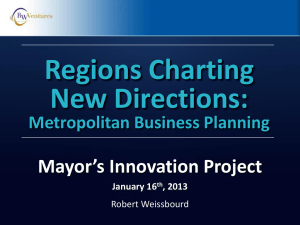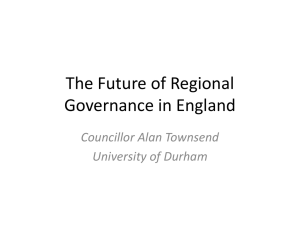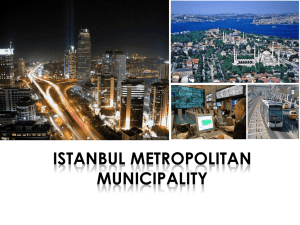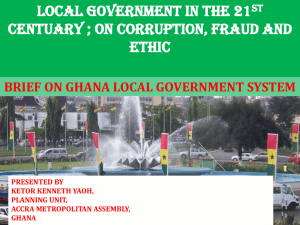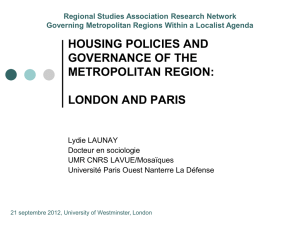Cooperation and strategic planning at the level of
advertisement
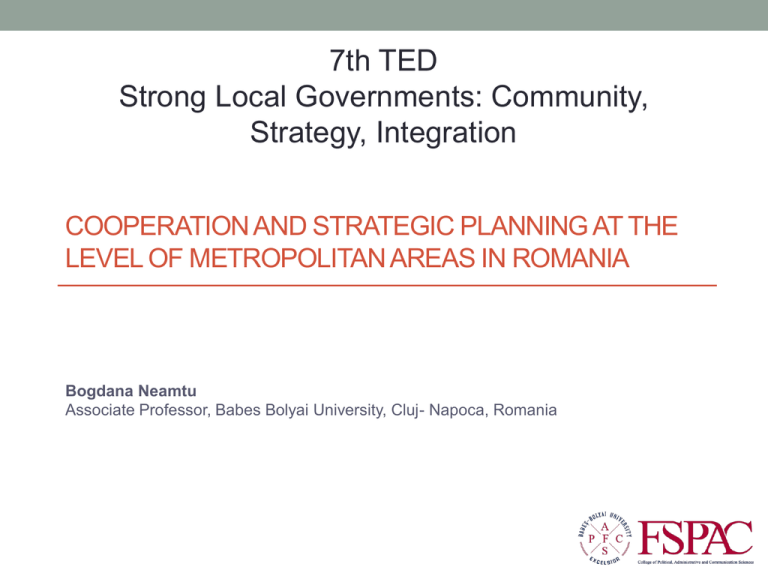
7th TED Strong Local Governments: Community, Strategy, Integration COOPERATION AND STRATEGIC PLANNING AT THE LEVEL OF METROPOLITAN AREAS IN ROMANIA Bogdana Neamtu Associate Professor, Babes Bolyai University, Cluj- Napoca, Romania Research focus • Current research: the place of land use and spatial planning within the strategic planning process at the level of metropolitan areas in Romania • Past researches: urban sprawl in former communist cities and tools used to mitigate it • Why cooperation at the metropolitan level: most of the tools used in land use and spatial planning in order to be effective need to be applied at a spatial level that is broader than the city itself Research focus (continued) • Additional evidence: - cities are sprawling beyond the administrative city limits; - many important urban centers are already built up so new investments need to be located to the outskirts/neighboring communities (sometimes investors look for greenfields as opposed to urban infill); - EU cohesion funds commonly available for regional/metropolitan projects, etc. • Several examples of planning tools used at metropolitan level: - master plans/development strategies (non-binding legal documents) - land use plans (legally binding documents) - urban service/infrastructure boundaries /urban growth boundaries Metropolitan areas in Romania • Legal possibility to create them – since early 2000 • Main challenge: Romanian Constitution defines very clearly the territorial units which can govern themselves; metropolitan areas and regions are not among them • Difficult to change the Constitution • Cooperation therefore at the local level – based on association of existing administrative units • However, no budget (no financial autonomy), limited responsibilities (delegation) Metropolitan areas in Romania (continued) • The movement to establish metropolitan areas took off very • • • • slowly in the early 2000 Problems concerning the leading actor in the creation of the metropolitan area; competition among the city and the neighboring communities; local authorities not sure what the purpose/functions of cooperation at metropolitanlevel could be Past failures (semi-failures) with other inter-municipal cooperation forms (associations for intercommunity development) It wasn’t until 2008 when the major urban centers were „forced” to establish metropolitan areas (EU funds/Regional Operational Program) The desire to establish a metropolitan area had in many cases no connection with the size of the urban aglomeration, extent of urban sprawl, level of economic or spatial integration, etc. Research methodology • Survey followed by face to face interviews • Scrutiny of development strategies/integrated urban development plans • Sample: 20 municipalities (7 are growth poles – 1st tier in the hierarchy of urban centers; the other 13 are urban development poles (2nd tear) – designation through law in he framework of one of the operational programs financed) • For each municipality (at least 2 elected representatives – local councilors, where possible the mayor; 2 public servants dealing with land use planning and strategic planning) Research methodology (continued) • Main areas of investigation: - Triggers leading to the establishment of metropolitan areas? Any spatial/urban planning considerations among them? - When creating the master plan/integrated development plan for the metropolitan area, was land use planning a priority? What about urban sprawl mitigation? - Areas/policy sectors for which the efficiency of metropolitan areas is already proven? - Future of metropolitan areas/government: Would you support the creation of metropolitan government with elected bodies, financial autonomy?; Metropolitan areas versus regions versus consolidation of local government; Strategic planning – joint, continuous responsibility of all units comprized in the metropolitan area? Creation of metropolitan areas • For those cities which initiated the creation of metropolitan areas in early 2000 – an „experiment”; no precise motivation other than transplantation/adaptation of best practices from abroad • Some mayors/presidents of county councils – participation in various networks at international level/exposure to metropolitan government • Later on – attraction of EU funds/possibility to implement joint projects/other financial incentives Creation of metropolitan areas (continued) • Until 2009 no strategic planning efforts undertaken at • • • • • metropolitan level This changed with the legal requirement under the growth poles legislation Metropolitan areas required to draft integrated plans for urban development Eligibility condition for obtaining EU cohesion funds (Pregional Operational Program, Axis 1 – Sustainable cities) Strategic planning carried out so that the legal requirements can be fulfilled The resulted integrated plans were often copy-pasted; standardized model used by all metropolitan areas; were little efforts made to adapt it to local context/needs Land use planning important? • Spatial planning – especially integration of economic activities at the level of the metropolitan territory is present as a concern but not as a priority • Land use planning seen as something that needs to be done at the level of each administrative unit • No strategic dimension of land use planning • Possible explanation: Way in which planning practice and profession was established and it is carried out in Romania Land use planning important? (continued) • Planning theory and practice guided by the distinction between Anglo-Saxon urban planning and Latin urbanism • Anglo-Saxon planning – rational method and theory of planning as intervention; separation from architecture as o profession • Urbanism – architecture, urban morphology, reintegrating planning with its mother discipline • Though our planning system is sometimes described as comprehensive integrate – in reality more oriented toward land use regulations/zoning Land use planning important? (continued) • In the integrated development plans no clear and systematic presentation and analysis of data (migration/comuting flows; shift/share analysis, etc.) to prove if urban sprawl is a problem • Mitigation/control of urban sprawl not considered • More focus on economic development tools and projects that match the EU funding priorities/objectives Do metropolitan areas work in Romania? • Framework for prioritizing and implementing investments/projects • • • • • financed from EU money (Regional Operational Program) Overlaps with other structures for intermunicipal cooperation – Cluj county there is one association for integrated waste management; one They are all intertwined but still apart – coordination problems Local actors are discovering that for certain activities they need to redesign the boundaries of the metropolitan area (for public transport for ex. only first ring rural communities and the city) Areas with potential for cooperation at the level of metropolitan areas – provision of public services/utilities; public transportation, economic development Land use planning – clear no; competition rather than cooperation; each administrative unit wants to maximize gains/autonomy wanted especially by the communities which are able to attract new residents/businesses Do metropolitan areas work in Romania? (continued) Future of metropolitan areas • Local authorities aware of the fact that at least for now • • • • reformation of metropolitan areas is not a priority for policy makers/legislators Most of them agree with this option and with the need to focus on regions and further decentralization (increased responsibilities for county councils) Almost all see no need for elected metropolitan government – what they oppose in fact is the loss of financial autonomy The city/metropolis should have the final decision/leading/senior partner in the association Especially wealthy rural communities oppose metropolitan government Future of metropolitan areas (continued) • Currently strategic planning is carried out in a systematic manner only at the level of each admin. territorial unit • Integrated plans for the metropolitan area – one time efforts; seldom do local authorities go back and readjust priorities; formality needed in order to be eligible for EU money • Current institutional framework not conducive towards continuous strategic planning (no permanent structures; they meet when needed with staff and assistance usually provided by the municipality • Interesting to follow the next programing cycle (20142020) – current integrated plans expire in 2015 Questions for discussion • Given fragmentation and reduced administrative capacity at the local level – metropolitan zones/areas seem as a good solution. Or don’t? • What can be done to find them a place within the structure of the Romanian local public government? Should we even strive for this? • Perhaps clearly define what metropolitan areas have to do, what problem they are required to solve • If strategic planning is to take place at metropolitan level then some sort of permanent institutional structure needs to be established
